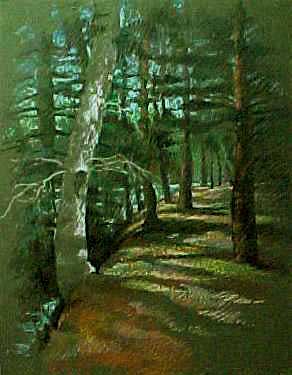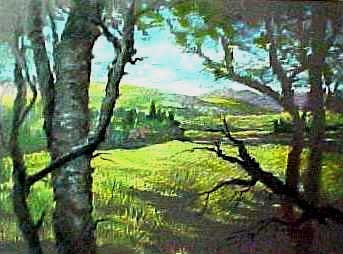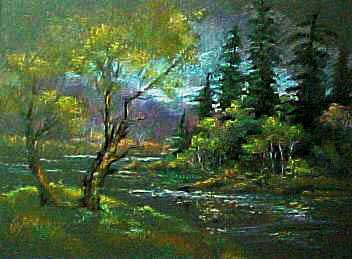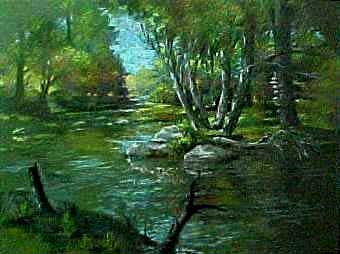Fine Art Pastels Techniques
Pastels
on paper are great for working "en plein aire" (outdoors)
as there are no liquids to spill or carry and no brush clean
up. I sometimes do them first and then translate them into
either oil
or
acrylic paintings, which I can work up in the studio, where
the light is controlled and clean up is easily done. I carry
a smaller
selection
of chalks for this outdoor work, and sometimes work on smaller
pieces of pastel paper, doing several versions of a particular
scene.
A
drawing board and a portable easel are about the only other equipment
needed. A clipboard is also easily carried over rough ground.
Remember, when working outdoors, that the light changes as the
day wears
on. About an hour is maximum. Try working the same scenic view
as separate
pastels done at different times of day. Use plastic gloves or
finger cots if you want to keep the chalks away from the fingernails
while
working. Both are inexpensive and eliminate washing up before
leaving the site. Otherwise, carry a box of Kleenex.
My
pastels are done
without blending for the most part. I use them as a drawing
technique. I don't
try to hide the strokes of the chalks with a lot of blending
as would be done in a painting. I usually use a full sheet
of 19 x
25 pastel
paper. My preference is a French paper called Mi Teints by
Canson. These fine papers come in 50 different shades to please
any palette.
I never use white paper. These sheets have two surfaces, rougher
vellum on one side and a flat finish on the other. These papers
will also
accept watercolor, ink and acrylic, and are long lasting and
archival. I have used Dick Blick as my art supply house for
years, first
as an art supervisor during my years as an art educator, and
in my own studio
since retirement in 1986.
I
choose a shade or tint that seems to suit the image. If it is
a fall scene, then I use an orange
or
pink sheet.
If an interior, then a cooler tone is chosen. I have found
that a color-opposite choice enhances the brilliance of the
finished drawing and that a close-color
choice softens the finished work.
I
use Prismacolor Nupastel color
sticks which are about 3/8 of an inch square and about
four inches long. They
are lacquered and very little color gets on my fingers.
I started using these in 1951 and have always used them since.
I have
a very large
selection of colors, tints and shades. In addition to these,
I have a 28 stick set of Conte pastel pencils, which can
be sharpened to a
point for precise detail work. I also use General's white
charcoal pencils and their 6B black charcoal pencils for precise
details.
I
never use fixative! I have drawings that are now more
than fifty years old
and the ones that were "fixed" have foxed and spotted, making
the drawing useless. The others are as they were made without evidence
of deterioration.
I
begin my pastel by choosing a chalk that is a shade lighter or
darker than the paper color. I block in the main elements
of the image, without too much attention to accuracy.
I then start working up the background colors and tones, choosing
tones that begin
to suggest the sky if it is a landscape, or the shadows
or highlights of the background in a still life. Then the middle
areas and, finally,
the closer details.
When
I work outdoors, I know that I will have to adjust the colors
for inside lighting, so details
are left for that
time. If I am working in the studio from the beginning,
then I don't need to worry, as the result does not change with
indoor lighting.
I
do not try to blend and hide the strokes of the various
chalks and pencils. I expect the viewer to see these drawings
from a distance
and not close up, as would be the case for book illustration
or miniature works. Blending with stumps and fingers diminishes
the vibrancy of
the colors and, at least for me, makes a less exciting
work of art.
Pastels
can be double matted with the inner mat cut in the reverse to
catch
any stray chalk mites that might fall from the finished
work, perhaps by a jolt or careless handling of the framed
work. A UV inhibiting
acrylic can now be used to protect the papers from
fading. Even so, it is not a good idea to let any type of drawing
on paper be exposed
to direct sunlight, and they are better hung on inside
walls or other places where they do not receive too much light.
White
Birch, Newport, NH
Pastel
on toned paper 19 x 25

Towards
the Airport, Newport, NH
Pastel
on toned paper 19 x 25

Near
the Corbin Bridge, Newport, NH
Pastel
on toned paper 19 x 25
2001

Spring
at Meadow Park, Newport, NH
Pastel
on toned paper 19 x 25
2001

The
Sugar River Meets the Corbin Brook, Newport, NH
Pastel
on toned paper 19 x 25
2001

